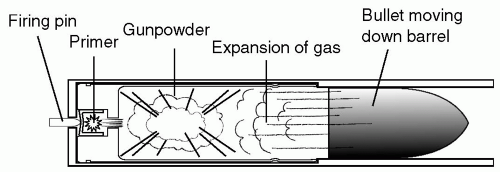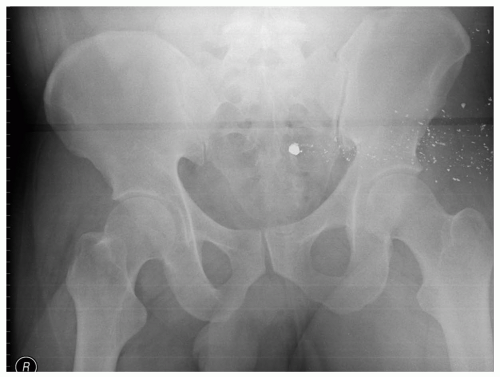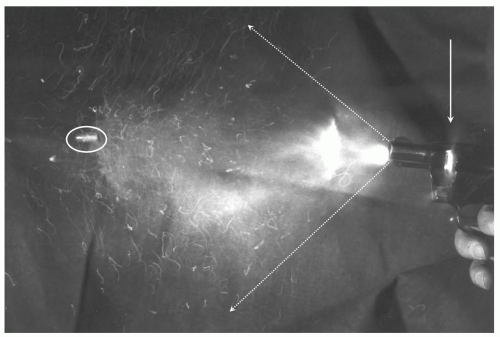Gunshot Injury: Overview of Ballistics, Wounding, and Clinical Management Principles
Mark L. Gestring
Brian James Gestring
No injury is associated more strongly with the field of trauma surgery than the gunshot wound. Despite the fact that blunt trauma occurs more commonly than penetrating trauma, firearms represent a significant injury mechanism and remain a fact of life in the United States. More Americans have lost their lives to firearms since 1933 than the combined total of all American soldiers killed in every war they fought.1 Despite this, firearm injury and fatality rates in the United States continue to increase.2,3 According to recent Federal Bureau of Investigation (FBI) statistics, almost 30% of all violent crimes and dose to 70% of all homicides in the United States involve firearms.4 In addition, firearm injury is becoming a significant health problem for the nation’s youth. A 75% increase in firearm deaths has been reported in the 15- to 19-year-old population over the last 2 decades,5 and death by firearm has become the fifth leading cause of mortality in children younger than 14 years.6 Furthermore, an increase in the overall severity of firearm injury has also been noted. In one study, the proportion of patients with two or more gunshot wounds increased from 26% in 1987 to 43% by 1990.7 The widespread availability of firearms combined with improvements in weapon design and capacity have conspired in the development of this public health crisis.
Gunshot wounds are no longer unusual and their management is no longer restricted to the inner city, urban emergency room. A basic understanding of how firearms work, how tissue is injured, and how medical care is influenced by these principals is required to provide proper care for these patients. This chapter will provide an overview of the technical aspects of gunshot injury including basic ballistic theory, a review of factors contributing to firearm wound creation and, lastly, a review of proper legal procedure and evidence management.
BASIC BALLISTICS
Classically described, ballistics is the study of projectile motion. Currently, however, this term applies to both the study of projectile behavior as well as the physics of firearm design and function.8 While there are many types of projectiles and firearms, the basic principles that govern their relationship remain remarkably constant. When treating patients with gunshot wounds, an understanding of the factors that determine and maintain this relationship can be very helpful.
The study of ballistics is best divided into three distinct components—internal, external, and terminal or wound
ballistics. Internal ballistics is the study of projectile behavior within the firearm. Although this includes all aspects of projectile construction and design, the primary focus is on the internal workings of the firearm and the conversion of chemical energy in the form of propellant to kinetic energy (KE) in the form of projectile motion. External ballistics refers to the forces that act on a projectile during its flight to the target. Lastly, terminal or wound ballistics describes the interaction of target tissue with the projectile and the factors involved with wound creation. A complex topic can be simplified somewhat when each of these is discussed individually.
ballistics. Internal ballistics is the study of projectile behavior within the firearm. Although this includes all aspects of projectile construction and design, the primary focus is on the internal workings of the firearm and the conversion of chemical energy in the form of propellant to kinetic energy (KE) in the form of projectile motion. External ballistics refers to the forces that act on a projectile during its flight to the target. Lastly, terminal or wound ballistics describes the interaction of target tissue with the projectile and the factors involved with wound creation. A complex topic can be simplified somewhat when each of these is discussed individually.
Internal Ballistics
Internal ballistics refers to the study of projectile motion and behavior within the weapon itself. The projectile, or bullet, is initially contained within a cartridge, which is inserted into the weapon for firing. Virtually all cartridges are similar in design, consisting of a shell casing that contains the other components necessary to fire the bullet. At the base of the cartridge, there is a very reactive chemical known as the primer. The firing pin from the weapon strikes the primer causing an explosion. This explosion ignites the less reactive propellant powder, which is housed in the shell casing and causes it to expand to fit the diameter of the barrel. The gases produced by the burning powder can only escape by forcing the bullet down the barrel (see Fig. 1). As the bullet accelerates through the barrel, it acquires spin from rifling, or spiral grooves, cut into the inner core of the barrel. Rifling increases the accuracy and velocity of the projectile in flight and imparts certain markings on the bullet that can later be used to identify the specific barrel that fired the bullet. Generally, a bullet will continue to increase its velocity as long as it remains within the barrel because of the contained gases propelling it in the closed space. Once the bullet leaves the barrel, the propulsive gases are quickly dissipated and the projectile is moving at its highest speed, referred to as its muzzle velocity. In addition to the bullet, hot gases and propellant powder in different states of thermal decomposition exit the barrel as a result of the process described in the preceding text (see Fig. 2). This is clinically relevant because these gases can cause burns to tissue known as powder stippling, which can be used to estimate firing distance. A burn found in conjunction with a gunshot wound suggests close-range injury. Despite the intense heat associated with this process, bullets are not sterile and can be the source of clinical infection.9,10
 Figure 1 Diagrammatic representation of a cartridge being fired. (Illustration by Mark Schoemann, MD.) |
Because the muzzle velocity of a projectile is ultimately determined by the amount of gunpowder propelling it, the weight of the projectile, and the length of the barrel through which it accelerates, velocity is an important characteristic used to classify firearm groups. Most handguns currently encountered are considered low-velocity weapons with muzzle velocities <2,000 ft per second. The classic high-velocity weapon, by comparison, is the rifle which has a longer barrel, a large propellant-rich cartridge, and muzzle velocities frequently in excess of the 2,000 ft per second range. Firearms can be further classified by caliber, which refers to the diameter of the bullet and can be designated in metric (mm) and standard (inches) units. This classification can be used to differentiate specific types of guns, but should not be used to predict injury patterns because there are many variables for each type of weapon.
Bullets can be composed solely of soft lead or lead covered by another, harder metal. This design modification is known as jacketing and is used for bullets fired from semiautomatic weapons to prevent the soft lead of unjacketed rounds from jamming autoloading mechanisms. Jacketing also helps maintain the shape of the bullet and limits fragmentation when it reaches its target. It is possible for the jacketing to separate from its lead core on impact. The presence or absence of jacketing, as well as the extra missile that is created if the jacket separates, has significant implications on wound creation, which is discussed later in this chapter.
Once the bullet leaves the barrel, the spent cartridge must be removed to fire the next round. Depending on the type of firearm, the cartridge case is either retained in a cylinder for later removal or automatically ejected by the weapon
as the next round is fired. Both the sides and the base of the shell casing may be used to associate it with a specific weapon, and fingerprints can sometimes be obtained from the shell casing itself.11 For this reason, ejected cartridges are important forensic evidence and should be handled appropriately if they are encountered in the clinical setting.
as the next round is fired. Both the sides and the base of the shell casing may be used to associate it with a specific weapon, and fingerprints can sometimes be obtained from the shell casing itself.11 For this reason, ejected cartridges are important forensic evidence and should be handled appropriately if they are encountered in the clinical setting.
External Ballistics
External ballistics refers to the study of projectile behavior while in flight. It includes those factors which impact forward motion and flight stability of the bullet. The concept of external ballistics, however, starts with an understanding of how the ballistic coefficient, or the ability of a bullet to overcome air resistance, affects its flight characteristics. This is based largely on the sectional density and shape of the projectile where pointed bullets encounter less air resistance than round ones. Most modern bullets have a pointed shape with the notable exception of shotgun pellets, which exhibit poor flight characteristics over longer distances.
The study of external ballistics is, in fact, the study of total KE transfer from the weapon to the target. Firearm designers have employed numerous modifications and enhancements to both weapons and bullets to increase the efficiency of this process and maximize transmission of KE to the final target. The main contributors to the final KE are velocity (V) and mass (M) of the projectile. This relationship is expressed by the formula KE = ½ MV2. Velocity is believed to be one of the major determining factors in predicting the effectiveness of a bullet; however, it is easier in practice to increase the mass of a projectile than to increase its velocity without major structural changes to the weapon. Because KE is measured in ft-1b and bullets are measured in grains of weight (7,000 grains in 1 lb), a conversion to mass must be performed using the formula M = W/7,000 g. The resulting KE value provides an indication of the potential of the bullet for tissue destruction. The actual wounding potential, however, depends on additional factors, which will be discussed in further detail later in this chapter.
As described in the preceding text, rifling within the barrel of the firearm imparts a stabilizing spin on the bullet in its flight from the weapon. Without this spin, the path of the bullet would be far less predictable and tumbling as well as other aberrations may interfere with the motion of a bullet. A similar effect is observed when bullets are destabilized by striking intermediate targets. This often accounts for unusual trajectories and nontraditional entry wounds.
Terminal or Wound Ballistics
This aspect of ballistic study deals with wound creation and the interaction of the moving projectile with the target tissue. As described in the preceding text, potential tissue destruction is predicted by the relationship between velocity and mass. Actual tissue destruction, however, is dictated by projectile shape, projectile construction, and target tissue type.12,13
In general, an impact velocity of only 125 to 230 ft per second is required for a bullet or fragment to penetrate the skin.14,15 A bullet causes tissue injury in three main ways. First, it directly crushes the tissue as it penetrates leading to what is referred to as the permanent cavity. The size of the permanent cavity is largely dependent on bullet size and design. Many modifications have been applied to bullets to allow deformation on impact with resultant larger permanent cavity formation in target tissue. Second, the bullet forces surrounding tissue outward away from the missile path as it penetrates. This tissue stretch is responsible for the temporary cavity,16 which is a transient displacement of tissue, or a localized blunt trauma, caused by the cavitation of the passing projectile and is usually directly related to velocity. Elastic tissues such as bowel, lung, and muscle are relatively resistant to damage by stretch, whereas solid organs such as liver and brain are not.17 The actual wound produced by a particular penetrating projectile is characterized by the amount and location of tissue crush and the degree of stretch. Although all bullets cause a permanent cavity when they penetrate tissue, the creation of a temporary cavity is usually limited to high-velocity weapons such as rifles. Stretch from temporary cavity tissue displacement can disrupt blood vessels or break bones at some distance from the projectile path; however, this phenomenon is also limited to wounds caused by high-velocity weapons. Fortunately, most wounds are created by handguns that usually cause injury by damaging tissue in the path of the permanent cavity. Cavitation and temporary cavity formation are generally not significant factors in wounds created by handguns.18
The third major factor in wound creation is fragmentation. This happens when the bullet separates or splits apart into smaller pieces on impact with the target tissue or, on occasion, before tissue penetration. This is common with soft lead bullets and can result in major tissue disruption. Each individual fragment of the bullet is capable of creating its own wound tract and increasing the overall destruction within the target tissue, resulting in a larger permanent channel. Fragmentation can be recognized on x-ray as debris, which is distributed widely along the bullet tract.19 (see Fig. 3) A bullet striking bone may cause fragmentation of the bone as well as the bullet with subsequent formation of numerous secondary missiles, which are often more destructive than the primary missile and often take erratic and unpredictable courses (see Fig. 4).
Bullet wounds can be classified as low- or high-velocity wounds based on the criteria described in the preceding text. Low-velocity projectile wounds are generally considered to be less severe, more common in the civilian population, and typically attributed to projectiles with muzzle velocities <2,000 ft per second. While significant injuries and death can occur in this group, they are usually
the result of direct bullet penetration and permanent cavity formation through specific tissues or vital structures. In an attempt to increase tissue destruction, however, various projectile modifications have been developed. The most common of these is the hollow-point, soft-tip, deforming bullet. This bullet is designed to flatten out on impact in order to create a larger wound tract and to transfer as much KE to the target as possible. Although there are many theoretic advantages to such a design, many factors interfere with the reliable expansion of these bullets.
the result of direct bullet penetration and permanent cavity formation through specific tissues or vital structures. In an attempt to increase tissue destruction, however, various projectile modifications have been developed. The most common of these is the hollow-point, soft-tip, deforming bullet. This bullet is designed to flatten out on impact in order to create a larger wound tract and to transfer as much KE to the target as possible. Although there are many theoretic advantages to such a design, many factors interfere with the reliable expansion of these bullets.
 Figure 3 Pelvic radiograph of a high-velocity AR-15 wound to pelvis. Note the significant fragmentation, which delineates the bullet path on x-ray. |
Overall, tissue damage is usually more severe with high-velocity (>2,000 ft per second) military and hunting weapons, where the effects of the temporary cavity described in the preceding text may be seen.20,21 It is misleading, however, to assume that the severity of a gunshot wound is solely due to velocity.22,23 As described earlier, many factors including bullet deformation, bullet fragmentation, and biologic characteristics of target tissues are responsible for the ultimate wounding capability of a weapon.
Stay updated, free articles. Join our Telegram channel

Full access? Get Clinical Tree








